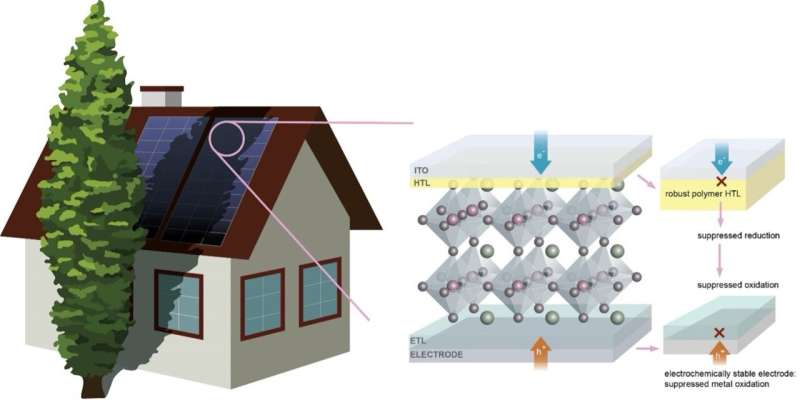September 2, 2024 feature
This article has been reviewed according to Science X's editorial process and policies. Editors have highlighted the following attributes while ensuring the content's credibility:
fact-checked
peer-reviewed publication
trusted source
proofread
Engineering approach can improve stability of perovskite solar cells under reverse bias conditions

Solar cells based on perovskites, a versatile class of materials with promising optoelectronic properties, are gradually making their way toward commercialization. While these solar cells can have notable advantages over existing solar cell designs, including higher power conversion efficiencies and lower fabrication costs, their performance has been found to be significantly impaired in reverse bias conditions.
Reverse bias occurs when one cell in a series-connected solar panel becomes shaded and generates less power. The remaining illuminated cells place a reverse voltage on the shaded cell, trying to push current through it in the wrong direction. This can lead to a serious degradation of the shaded cell.
Researchers at the University of Washington, the University of Colorado (UC) Boulder, Rice University, and the University of Oxford recently developed a new strategy that could help to improve the stability of perovskite-based solar cells under high reverse bias. Their proposed approach, published in Nature Energy, relies on a unique device architecture that combines a polymer hole transport layer with an electrochemically stable back electrode.
"We'd seen Mike McGehee give an inspiring talk on the importance of reverse bias stability and his team's work understanding it," David S. Ginger, Professor of Chemistry at the University of Washington and supervising author of the paper, told Tech Xplore. "We were at a point where Fangyuan Jiang was finishing one project and looking for a new one, and we agreed that this issue might be a good match for some of our research, specifically our surface passivation to stabilize perovskite/electrode interfaces and reduce ionic conductivity."
Initially, the researchers tried stabilizing perovskite solar cells using a surface passivation technique, but this approach proved ineffective. Jiang, the lead author of the paper, then came up with the idea behind their newly proposed strategy, which they first tested at UW and then analyzed further in collaboration with Michael D. McGehee and his team at UC Boulder, as well as the teams of Profs. Aditya Mohite at Rice, and Henry Snaith at Oxford.
"We engineered our solar cells through two steps: using robust polymer hole transport material to block electron injection; using electrochemically stable electrode material to prevent metal oxidation," explained Jiang. "We think that the early-stage cell degradation under reverse bias is an electrochemical process triggered by injected charge carriers."
The novel engineering approach devised by Jiang, Ginger and their colleagues can regulate the electrochemical reactions leading to the early degradation of solar cells under reverse bias. This, in turn, stabilizes the cells in the presence of a relatively high reverse bias.
"Our approach would probably be most suited for a solar module design that incorporated bypass diodes, like has been the case for many silicon solar cell modules," Ginger explained. "I think it gives some hope that one might be able to design all-perovskite stacks that are also stable when passing reverse current, though that could be more challenging."
The researchers used their engineering strategy to create new p-i-n solar cells and assessed their performance. They found that these cells were stable under large reverse voltages, comparable to those that conventional silicon-based cells can withstand.
"We showed that perovskite solar cells are not inherently unstable to reverse voltages," said Ginger. "I think this is really a change in mindset for many. In addition, our study shows that we need to think holistically: it isn't just one interface or another that is the key, it is engineering the entire device stack."
The promising results achieved by Ginger, Jiang and his colleagues could encourage other teams to experiment with their proposed design strategy. This could contribute to the development of more reliable perovskite solar cells that are stable under reverse bias conditions.
"I think the importance of our study also extends beyond solar cells, as our engineering strategy could serve as a source of inspiration for other optoelectronics such as photodetectors and light-emitting diodes (LEDs)," said Jiang. "I am also proud of the rigorous presentation of our work, thanks to a great team. I hope the fundamental electrochemical insights can also inspire future reverse bias studies."
The recent work by this team of researchers could contribute to the future commercialization of photovoltaics (PVs) based on perovskites while also informing the development of other optoelectronic devices. Meanwhile, Jiang, Ginger and their colleagues plan to carry out further research investigating the mechanisms underpinning the degradation of perovskite cells under reverse bias and/or passing high reverse current.
"We'd now like to understand the remaining mechanisms of failure under reverse current flow and see if we can find ways to enable them to pass reverse current close to the max power current operating in the sunlight, but without irreversible damage," added Ginger.
More information: Fangyuan Jiang et al, Improved reverse bias stability in p–i–n perovskite solar cells with optimized hole transport materials and less reactive electrodes, Nature Energy (2024). DOI: 10.1038/s41560-024-01600-z
© 2024 Science X Network
















